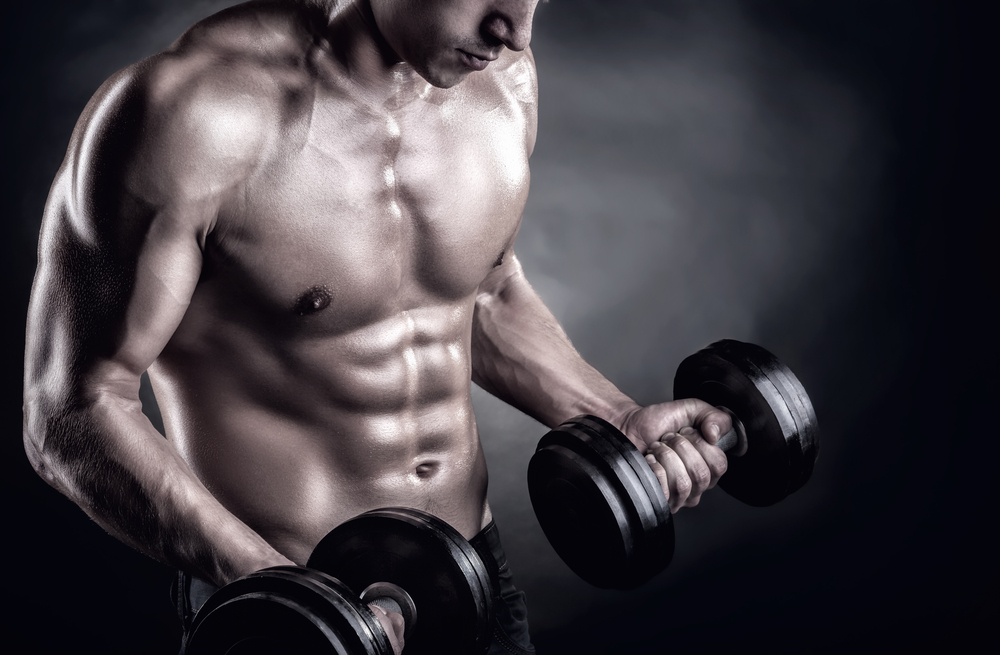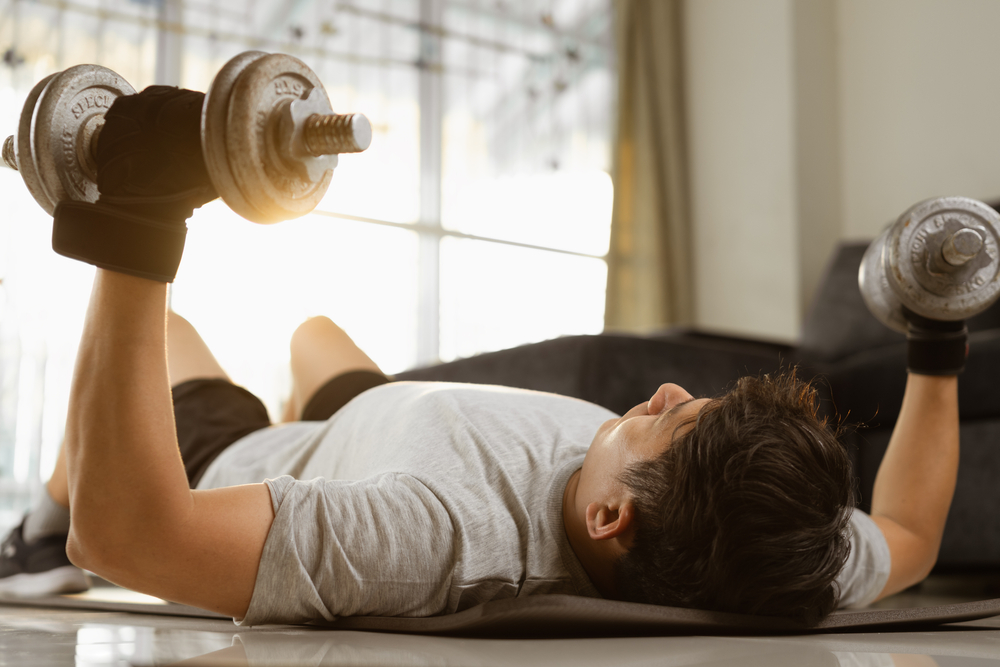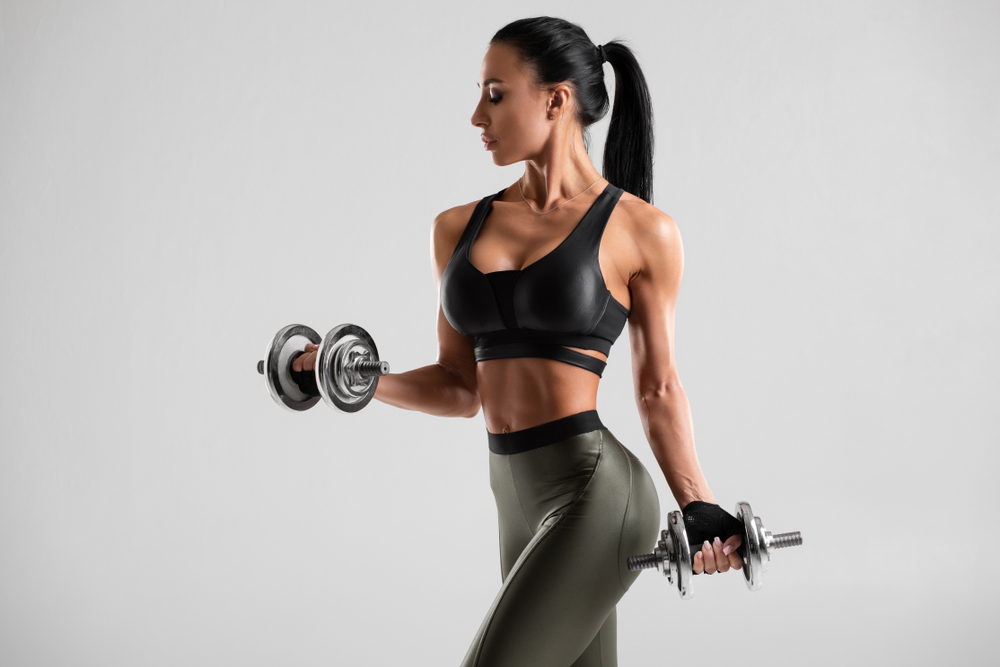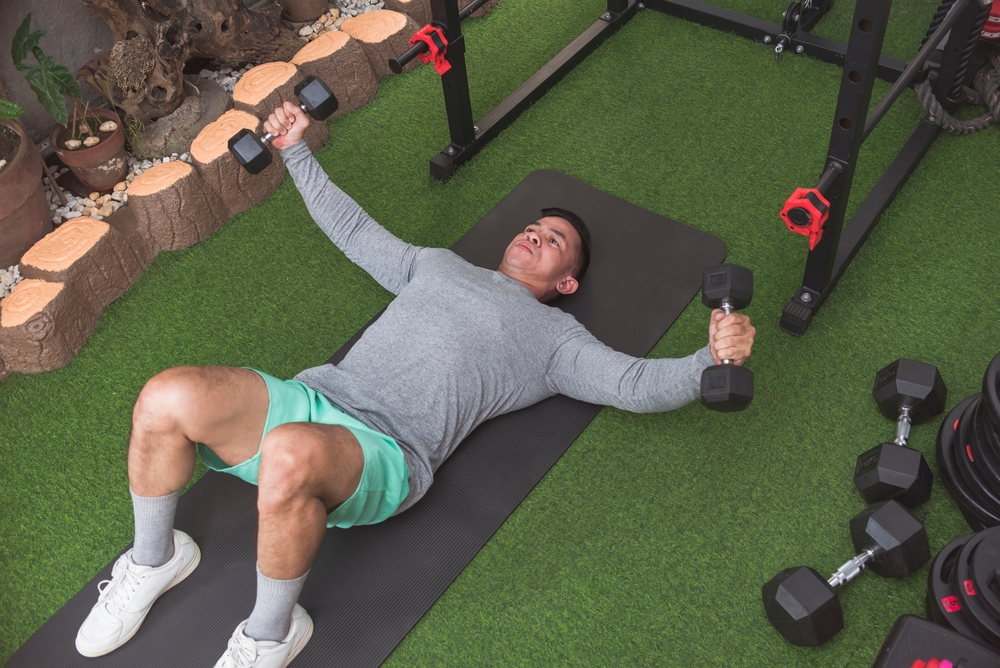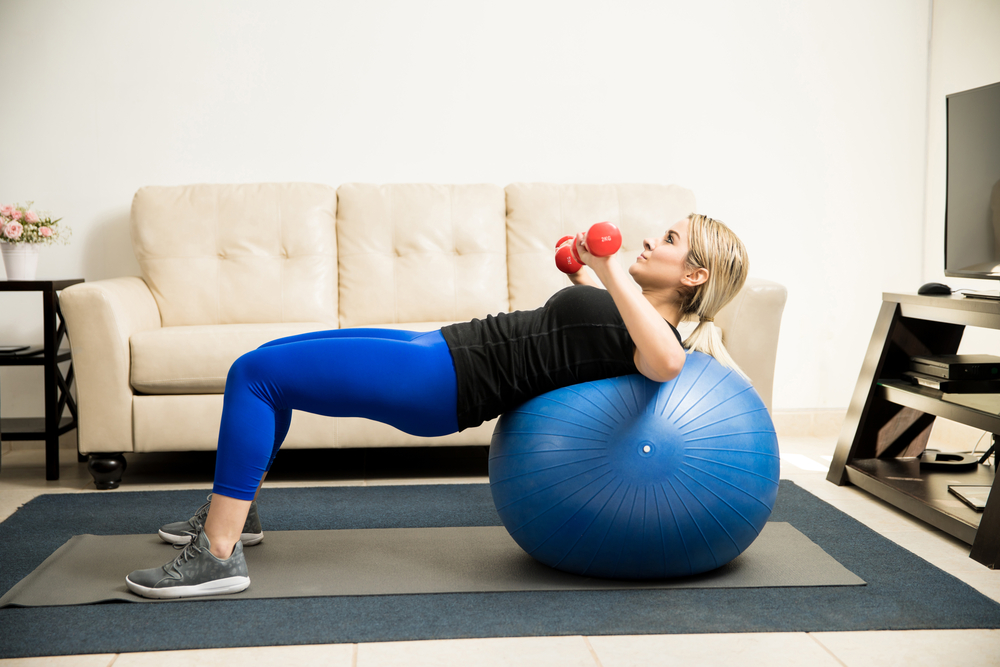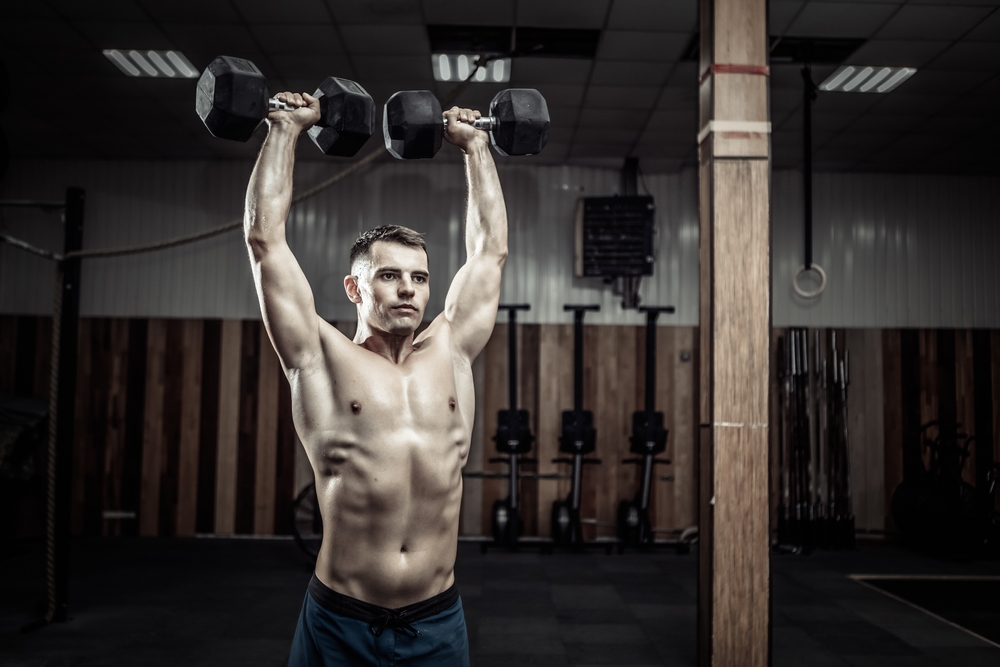Sculpting a great chest requires hard work and dedication. You’ll also need an intelligent approach that activates the right muscles the right amount. Dedicated gym rats live and die by the bench press, but that’s not the only way to get things done. Push-ups and gym machines can help get the job done too.
You don’t need a bench to perform a dumbbell chest workout, as these can be performed while standing, seating, or lying on the floor. Top dumbbell chest exercises without a bench include Chest Press, Hammer Press, Standing Dumbbell Upward Fly, Svend Chest Press, and Dumbbell Pullover on Swiss Ball. These workouts will engage your chest, triceps, deltoids, rhomboids, and abdominals.
For the benefits of using dumbbells and sample workouts to start using today, read on!
Contents
- How Do You Build Chest Muscles with Dumbbells Without a Bench?
- Top 12 Dumbbell Chest Exercises Without a Bench Press
- 1) Dumbbell Floor Chest Press
- 2) Dumbbell Floor Hammer Press
- 3) Standing Dumbbell Upward Fly
- 4) Standing Dumbbell Chest Press
- 5) Standing Dumbbell Svend Chest Press
- 6) Dumbbell Pullover on Swiss Ball
- 7) Dumbbell Incline Press on Swiss Ball
- 8) Dumbbell Fly on Swiss Ball
- 9) Dumbbell Incline Fly on Swiss Ball
- 10) Dumbbell Deep Push-up
- 11) Renegade Rows
- 12) Dumbbell Tricep Push-up
- Standing Chest Workout with Dumbbells
- Lower Chest Workout at Home with Dumbbells
- What Muscles Does a Dumbbell Chest Workout Engage?
- Benefits and Drawbacks of Dumbbell Chest Workout
- Best Exercises to Bulk Up Chest
- Best Supplements for Chest Growth
How Do You Build Chest Muscles with Dumbbells Without a Bench?
True fitness enthusiasts know that the bench has value, but there are other ways to build an excellent upper body.
Dumbbells are very versatile. They can be used while standing, seated, or lying on the floor. Even without a bench, you’ll have a lot of options in how to structure a workout involving dumbbells.
Dumbbells activate your chest similarly to a barbell. However, they take it a step further as you’re forced to stabilize two independently moving weights rather than one balanced bar. You target the same muscle groups but wind up hitting them harder, and no bench is needed.
Can I Do Chest Workouts on the Floor?
You can absolutely get a good benefit from chest pressing from the floor.
Make sure your shoulders stay touching the ground during your floor presses. If your neck or back lurch forward, you are risking injury to those areas. Be sure to place down your weights when the sets are done as well, as dropping them risks them bouncing onto your face.
Top 12 Dumbbell Chest Exercises Without a Bench Press
1) Dumbbell Floor Chest Press
The dumbbell floor chest press is basically a bench press, but from the floor using dumbbells. It will target your pecs and triceps big time. Ancillary muscles targeted include the rhomboids and the serratus anterior on your sides.
- Start from the floor with two dumbbells
- Bend your knees
- Plant your feet firmly on the floor
- Hold dumbbells with an overhand grip and elbows at 90 degrees
- Push up and fully extend your arms, squeezing your chest
- Slowly return to starting position
Never ever drop dumbbells while you are lying on the ground. Dumbbells tend to bounce, and you can seriously injure your face or head by dropping weights. In general, you should not drop them while standing either to protect your toes and ankles.
2) Dumbbell Floor Hammer Press
This exercise shows some of the benefits of dumbbells over barbells big time. Instead of pressing with the weights perpendicular to your body, you turn your hands to make the weights parallel. This activates the biceps more than your traditional bench, and hits the chest, tris, and delts hard.
- Start from the floor with two dumbbells
- Bend your knees
- Plant your feet firmly on the floor
- Hold dumbbells with a neutral grip and elbows at 90 degrees
- Push up and fully extend your arms, squeezing your chest
- Slowly return to starting position
You’ll get the best results alternating between the standard press and the hammer press to target everywhere in your upper body. What’s great about this is that you don’t even have to stand up, or even rest between sets of each.
Try a superset ladder as follows:
- 10 dumbbell floor chest presses
- 10 dumbbell floor hammer presses
- Rest 60 seconds
- Repeat above, reducing rep count by 1 each time
You’ll complete 9-9-8-8-7-7…so on and so forth. It’s a great way to structure a chest workout and make your gym time efficient. Expect your upper body to be totally torched afterwards though!
3) Standing Dumbbell Upward Fly
The standing dumbbell upward fly is a great movement. It resembles a front raise, but the underhanded grip engages your mid and upper chest instead. You’ll also work the front delts, triceps, and biceps.
- Stand feet hip width apart
- Hold dumbbells in underhanded grip
- Slowly bring them to shoulder height
- Squeeze chest at the top
- Slowly return to starting position
We’re big fans of pyramid sets. Start at a lower weight with the dumbbells and do 12 reps. Rest, then increase the weight but do 10 reps. Continue in this fashion to complete 8, 6, 4, and finally 2 reps. By the time you reach 2 reps, the weight should be very challenging.
Be sure never to use a weight that forces you to compromise good form. Never.
4) Standing Dumbbell Chest Press
What’s great about this movement is that you only need one dumbbell to get it done.
- Stand feet shoulder width apart
- Hold dumbbell close to your chest
- Squeezing the weight between your palms
- Push weight forward, extending your arms
- Keep core tight
- Slowly return to starting position
Standing for the press helps engage the core and legs more than lying since you will need to hold a strong stance and tension in the core. Try alternating days to include some standing chest days and some seated or lying chest days. The variation will help keep you progressing and prevent plateaus.
5) Standing Dumbbell Svend Chest Press
Named for famed strongman Svend Karlsen, this standing movement uses one heavy dumbbell rather than two. It’s great for targeting your whole chest, delts, triceps, and serratus anterior.
- Stand feet hip width apart
- Hold heavy barbell vertically with both hands
- Slowly outstretch your arms upwards
- Keep shoulder blades pinched
- Slowly return to starting position
The Svend press can be combined with your standard press to hit your chest hard. Try this set for your next workout:
- 7 standing dumbbell chest presses
- 7 standing dumbbell Svend chest presses
- 7 push-ups
- 7 sit-ups
- Repeat x 3
This set engages your chest big time, but also ropes in the core to help you build mass but stay chiseled simultaneously. Make sure to use weights that are challenging but manageable for all 3 sets.
The Svend chest press is a great movement that changes how we activate our chest. However, it’s always risky to hold heavy weights away from the body in this fashion. If your form starts to suffer from fatigue, you can overtax your shoulders or elbows and cause joint problems over time.
Always be mindful of your form, and rest or stop when your form deteriorates.
6) Dumbbell Pullover on Swiss Ball
Incorporating a Swiss ball is always a great move. Being forced to stabilize both the weights and your body adds that extra element to maximize efficiency. In addition to hitting your upper body hard, you’ll feel this one in your core too!
- Sit on the ball with a dumbbell
- Slowly roll yourself down until your head is hanging off the ball
- Keep your back touching ball
- Push the dumbbell out from your chest and then hinge it behind your head
- Keeping strong elbows through movement
- Slowly return to starting position
Some folks call this movement a “skull crusher” too. It makes sense. You’re waving a heavy weight near your skull. Be extra careful and don’t overdo the weight on this one.
7) Dumbbell Incline Press on Swiss Ball
Bench press lovers know that a great standard press is great, but incorporating inclines and declines is essential. Inclines and declines attack your chest at a different angle. This helps sculpt in ways the standard press cannot. For the incline press, you’ll target your upper chest, triceps, delts, biceps, and core.
- Sit on the ball with a dumbbells
- Keep your feet planted on the floor
- Assume your standard pressing position with hands
- Push up until arms are fully extended
- Slowly return to starting position
For this press and all presses, take note of your shoulders and upper back. You want to fully extend your arms, but do not lurch forward with your shoulders or round your back. Doing so puts unnecessary strain and risks injury.
8) Dumbbell Fly on Swiss Ball
Want a wide chest? Flies are the essential movement to target your mid chest. Be careful with the weight on an exercise like this. The position requires outstretched and slightly curved arms and compromising this form will put undue stress on your elbows. Be careful.
- Sit down on the ball with dumbbells
- Roll into the same position as standard Swiss Ball press
- Hold the dumbbells close to the chest as you get situated
- Stretch arms out to your sides keeping the elbows slightly bent
- Bring your hands together and squeeze once they meet in the middle
- Slowly return to starting position
Imagine you are hugging a palm tree during the motion to keep an appropriate distance with your arms. Since you’ll be in the same position as the press, a great superset involves going from the press to the fly as follows:
- 10 dumbbell Swiss Ball presses
- 10 dumbbell Swiss Ball flies
Rest in between sets as needed. Approximately 60 seconds should be adequate. For your sets, you have options to do a decreasing ladder, as with the last sample workout we recommended, or you can do pyramid sets and do 12-10-8-6-4-2 reps of each movement with rest in between.
The choice is yours. We recommend trying one format one week and using the other in the next. You can get good results from the same movements. Varying how many reps and how much weight you use, however, can help you push through plateaus and keep the gains coming.
9) Dumbbell Incline Fly on Swiss Ball
Just like the incline press on the Swiss Ball, you can change the angle of your chest flies to hit the muscles in a different way. Sit on the ball and roll it to your back as with the incline press. From there, complete a dumbbell chest fly at the incline angle.
- Sit down on the ball with dumbbells
- Roll into the same position as standard Swiss Ball incline press
- Hold the dumbbells close to the chest as you get situated
- Stretch arms out to your sides keeping the elbows slightly bent
- Bring your hands together and squeeze once they meet in the middle
- Slowly return to starting position
Just as with the regular presses and flies, you can structure a set of incline movements as follows:
- 10 dumbbell Swiss Ball presses
- 10 dumbbell Swiss Ball flies
Or combine it all like this:
- 10 dumbbell Swiss Ball presses
- 10 dumbbell Swiss Ball flies
- Rest 120 seconds
- 10 dumbbell Swiss Ball presses
- 10 dumbbell Swiss Ball flies
- Rest 120 seconds and repeat
Shooting for 3 to 5 sets of the above will blast your chest and start helping you make progress before long. Incorporate this once a week, or twice if you’re really pushing for a better chest ASAP.
10) Dumbbell Deep Push-up
We’re talking about dumbbells today, but it should be noted that regular push-ups with no equipment are also great for chest building. The dumbbell variation adds some height to the movement and engages your arms and chest further.
In addition, the motion keeps your hands in a neutral grip and takes strain off your wrists as compared to regular push-ups.
- Get into push-up position with dumbbells shoulder width apart
- Lower yourself slowly until your chest is close to the floor
- Push up and return to starting position
This movement works your front delts, biceps, and core, but mostly blasts your upper chest and triceps. Do a generous number of push-ups and/or dumbbell push-ups daily or every other day to build fast arm strength and a sculpted chest.
11) Renegade Rows
Ready to get a compound movement that gives you the chest-targeting power of the push-up and the tricep-building power of the tricep?
Meet the Renegade Row!
- Start in the dumbbell push-up position
- Lower yourself and push yourself back up.
- Alternate pulling each dumbbell up to your side in bent-over row motion
- Repeat as needed
Want to make it extra killer? Try this on for size:
- 1 Renegade Row (push-up + 2 dumbbell rows)
- Jump feet to hands and stand
- 1 dumbbell thruster
- Return to the starting position
- Repeat for 10 reps
The result here is a dumbbell renegade row-burpee-thruster hybrid. Complete a set of 10 though, and you’ll basically have completed a great chest-building and full-body type metcon.
12) Dumbbell Tricep Push-up
For standard push-ups that target the chest even more, you can alter to use a closer hand positioning or do “diamond push-ups.” Basically, that means assuming your standard push-up position but then forming a diamond with your hands.
During the motion, you lower your body slowly and push back up, paying close attention not to flare out the elbows. You want to keep them locked in tight to prevent injury. This variation is more challenging than your standard push-up, so don’t be surprised if you can’t do them at first. There’s a learning curve.
Got the movement down? Good, because we’re adding dumbbells to the mix now. Place two dumbbells close together beneath your chest when you are at the top of the position. Lower your body down, and again be sure not to flare the elbows outwards. Push back up and repeat as needed.
Standing Chest Workout with Dumbbells
Dumbbells are great. You can perform most chest exercises from a seated, standing, or lying position. Among the standing chest workouts, you have options like the standing press, the Svend press, and the upward fly.
Try a set like this for your next workout:
- 5 heavy standing dumbbell chest presses
- 10 moderate standing dumbbell Svend press
- 20 light standing dumbbell upward flies
- Rest for 120 seconds
- Repeat x3
Going heavy on the first lift and moving to higher reps at lower weight is a great way to reach muscle exhaustion and get the most from your workout. Try the above during your next chest workout.
Lower Chest Workout at Home with Dumbbells
Alternating between standard, incline, and decline movements are the best way to target the whole muscle. For the lower chest, that means working in some declines.
How do we do that from home without a bench?
Simple– simulate the decline position by flexing your hips or placing your feet on something elevated. Once in a proper decline, complete some sets of decline chest presses and flies to hit the whole muscle.
What Muscles Does a Dumbbell Chest Workout Engage?
Of course, dumbbell chest workouts mostly engage your chest, including the pectoralis major and minor. Since you use your arms mostly during each motion, you’ll get an exceptional tricep workout and moderate bicep workout too.
Additional muscles that are used in dumbbell chest workouts include the deltoids, rhomboids, serratus anterior, and abdominals.
Keep in mind that angle also affects how the chest is targeted. Standard position, incline, and decline will all affect exactly how the chest is hit. We recommend alternating between these angles and prioritize a different one each chest day.
Benefits and Drawbacks of Dumbbell Chest Workout
Benefits of Dumbbell Chest Workout
Our bodies engage numerous stability muscles when using dumbbells to keep them from going everywhere.
- Because each dumbbell moves independently, they provide a greater range of motion as well.
- You’ll hit your pecs harder and get results faster incorporating dumbbell workouts into your regimen.
Dumbbells also allow you to work out a single arm to correct imbalances. If you have noticed one arm is noticeably larger or stronger, try using single arm lifts to correct the imbalance.
Drawbacks of Dumbbell Chest Workout
There are drawbacks to using dumbbells as well. The primary one is that they can be dangerous when using heavy dumbbells.
- Getting heavier dumbbells into the right starting position can be problematic.
- Dropping them poses additional danger, as they could bounce into something or someone.
Exercise caution when using dumbbells, especially when going heavy.
Best Exercises to Bulk Up Chest
The best way to start building mass is to mix heavy lifting and a protein-rich diet. We don’t mean a piece of chicken for dinner. We’re talking 20-30 grams of protein in each meal, and possibly a shake or two as well!
Getting enough protein? Good. Now you’ll need to challenge yourself on the lifts. Any of the aforementioned chest lifts will do, although flies are difficult to scale to heavy weights.
Mind your form when scaling up but make sure your last reps are very challenging. If you sometimes can’t actually finish that last rep, you’re probably doing it right.
Best Supplements for Chest Growth
A great diet and exercise regimen is great, but some supplements may help.
Whey Protein Powder
Whey protein is by far the most popular method for increasing your protein intake while keeping calorie counts low. The Optimum Gold Standard is one of the most popular choices. We still recommend getting most of your protein from wholesome foods, but a shake or two a day can be beneficial.
BCAAs
Branched-chain amino acids include essential amino acids like leucine, isoleucine, and valine. Consuming them before, during, or after the workout helps to encourage muscle growth while also preventing muscle breakdown. Adding a powdered BCAA to your water bottle at the gym is a great way to keep yourself energized during your lifts.
Here’s a great BCAA that’s also pretty tasty too!
Creatine
Creatine stacks are extremely beneficial to seasoned lifters, but it’s not for beginners. Misusing creatine could have dangerous side effects that could result in hospitalization. Consult your doctor before using this supplement.
That said, if you’re ready to augment your gains, pick up a good creatine supplement for your stack. For the first 5-7 days, consume approximately 20 grams of creatine daily, then drop the dose to 3 grams daily for the next 28 days.
Once the creatine cycle is complete, wait another 7 to 14 days before doing another. Creatine cycles should be used sparingly but, if implemented responsibly, they have excellent effects on your overall muscle growth.
